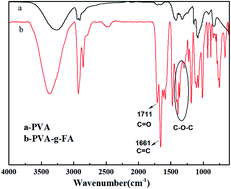A thermoreversible crosslinking hot-melt adhesive: reversibility and performance
Abstract
The need to improve the environmental friendliness and achieve the recycling of resins is an ongoing process for hot-melt adhesive technology. In this work, a new type of thermoreversible crosslinking hot-melt adhesive-based Diels Alder (DA) reaction was prepared. The critical idea was to efficiently initiate the esterification to yield furoic acid (FA)-grafted poly(vinyl alcohol) (PVA-g-FA), and then PVA-g-FA was mixed with N,N′-(4,4′-methylenediphenyl)dimaleimide (MDI) to finally obtain the thermoreversible crosslinking adhesive (PVA-g-FA/MDI). The experimental results indicated that the reversibility of the DA reaction between the furan rings and the maleimide groups allowed PVA-g-FA/MDI to be dynamically crosslinked. It was able to crosslink at a temperature of 80 °C and decrosslink at 120 °C. Moreover, the performances of hot-melt adhesive were investigated. The PVA-g-FA/MDI had a better peeling strength (43.33 N mm−1), bond strength (11.84 MPa), and thermal conductivity (0.263 W m−1 K−1) than PVA resins. The light-transmittance and haze value were 52.8% and 12.24‰, respectively. The PVA-g-FA/MDI resin could be reused more than two times.



 Please wait while we load your content...
Please wait while we load your content...